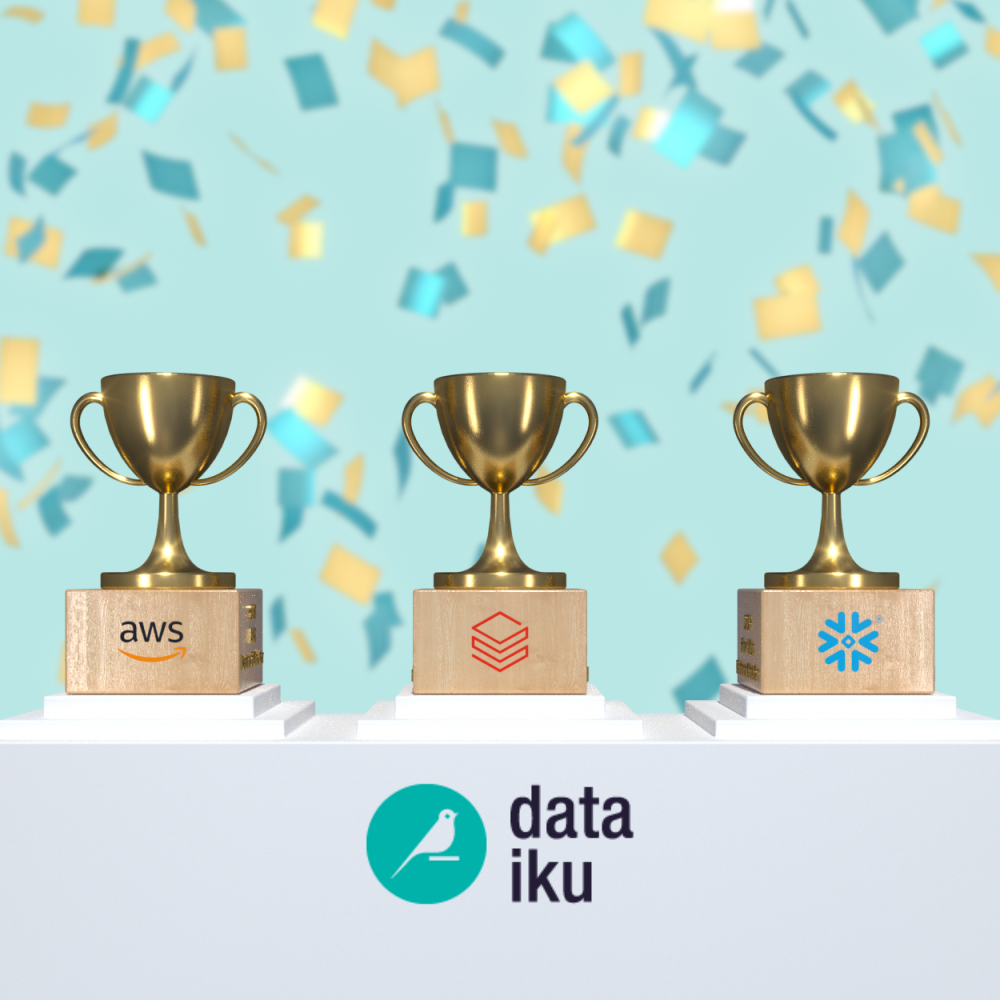IT leaders, data executives, and business decision-makers are moving beyond early GenAI experimentation and shifting their focus to operationalizing AI at scale for measurable impact. But with the landscape evolving rapidly, leaders must navigate key challenges: How do we differentiate in a world where generative AI (GenAI) models are becoming commoditized? How do we prove ROI and justify continued investment in GenAI? How do we implement AI governance without stifling innovation?
These challenges are already shaping enterprise AI strategy, as highlighted in our recently released report, "5 GenAI Trends for 2025: Beware the AI Agent Reckoning", which surveyed 400 data, analytics, and IT executives. These insights also took center stage in our recent webinar, “5 GenAI Trends That Will Shape 2025”. Led by four Dataiku Field CDOs — Conor Jensen, Stephanie Griffiths, Gernot Klein, and Catalina Herrera — this discussion explored the biggest AI shifts redefining enterprise strategy, from the explosion of LLM options to the growing urgency around governance and ROI.
The Macro Forces Driving AI’s Next Phase
Before diving into the five defining trends, it’s important to understand the broader socio-economic forces shaping AI’s trajectory. AI isn’t evolving in a vacuum — shifts in technology, regulation, and business strategy are accelerating its transformation.
New Players Are Redefining the AI Landscape
The AI ecosystem has transformed dramatically in the past year. A surge of new vendors, startups, and disruptive technologies is reshaping competition at an unprecedented pace. But as the number of models and providers grows, true differentiation no longer comes from simply having AI models — it comes from how effectively organizations orchestrate, integrate, and scale AI for real business impact.
Enterprises are moving beyond model selection and focusing on operationalizing AI at scale, embedding it seamlessly into workflows, and governing it effectively to drive measurable ROI. With more models, tools, and deployment options than ever before, organizations need a unified approach to managing, optimizing, and governing AI across multiple models and use cases.
The challenge isn’t just choosing the right model — it’s about orchestrating AI effectively to ensure flexibility, compliance, and long-term business value. Organizations that get this right will set themselves apart in an increasingly competitive landscape.
Open Source Is Accelerating AI Innovation
Open source AI has always been a driving force in machine learning and data science, but its role is expanding faster than ever. While the last few years were dominated by large commercial models, the rise of DeepSeek, Grok, and other open source initiatives is shifting power dynamics. Enterprises can no longer afford to ignore the flexibility, cost efficiency, and innovation potential that open source AI brings to the table.
Guardrails Are No Longer Optional
The AI race is no longer just about speed — it’s about control, compliance, and governance. Organizations are recognizing the urgent need for real-time, automated guardrails that ensure AI operates safely and ethically. Governance is no longer an afterthought; it’s now a key enabler of responsible and scalable AI adoption.
Reputation Is Now a Key AI Governance Driver
Who is emerging as an unexpected leader in AI governance? The Chief Marketing Officer (CMO). AI-generated content, automated decisions, and brand trust are now deeply intertwined. CMOs — once focused on AI for cross selling and next best offer — are stepping into critical governance roles to protect brand integrity and mitigate risk. AI strategy is no longer just for IT and data teams — it’s a cross-functional priority.
Why AI Needs an Interdisciplinary Approach
AI has never required more collaboration than it does today. Mathematicians work with linguists, data scientists partner with business leaders, and engineering schools are hiring philosophy professors. Interdisciplinarity fuels critical thinking and creativity—both essential drivers of AI innovation. We’re witnessing a shift in higher education, where science and humanities institutions are joining forces to shape the future of AI. One example is Paris Sciences & Lettres (PSL), which brings together renowned engineering schools such as Chimie Paris and the École Normale Supérieure to foster cross-disciplinary research and education.
This shift is equally critical in the enterprise, where AI success depends on collaboration between technical and business teams. Organizations that break down silos will be best positioned to scale AI effectively.
AI’s Energy Consumption Is Becoming a Competitive Factor
AI’s demand for computing power is skyrocketing, forcing enterprises to rethink how they source, manage, and optimize energy. Data centers, cloud providers, and AI-driven enterprises are confronting new sustainability challenges. Meanwhile, innovations in quantum computing and energy-efficient AI architectures may soon redefine the balance between AI performance and energy consumption. The companies that solve this challenge first will gain a major competitive edge.
New Work Processes
When electricity was first introduced, manufacturers struggled to harness its full potential because they applied it to existing processes rather than rethinking how work was done. The same challenge exists with AI today — businesses that try to fit AI into old workflows will limit its impact. Reimagining workflows will be essential to making the most of AI.
The 5 GenAI Trends Defining 2025
1. The Commoditization of LLMs
LLMs are no longer exclusive assets — they’ve become widely available, making differentiation harder than ever. As GenAI tools — and soon, AI agents in 2025 — become more accessible, basic AI capabilities will no longer be a competitive advantage, making it harder for companies to stand out with undifferentiated solutions.
As discussed in the webinar, companies are moving beyond simply deploying pre-trained models and are exploring ways to create more tailored, high-value applications. This means selecting the right models for different use cases, using techniques like Retrieval Augmented Generation (RAG) to enhance model accuracy with enterprise data, fine-tuning where needed, and integrating AI into broader workflows. With Dataiku, organizations can operationalize RAG efficiently, ensuring AI-driven insights are both relevant and context-aware. The key isn’t just customization — it’s about embedding AI into an organization’s unique processes and data to drive real differentiation.
2. Return on AI (ROAI) or Nothing
AI investments must deliver measurable business value or they will be deprioritized. CDOs and IT leaders are under increasing pressure to prove return on AI (ROAI), ensuring it directly impacts business outcomes. Enterprises investing in AI without clear alignment to strategic goals risk wasting resources and losing executive support. In 2025, if AI doesn’t drive real results, it won’t survive.
3. The LLM Mess Is Already Here
Organizations are waking up to a fragmented AI ecosystem — managing multiple models, vendors, and deployment strategies. In fact, according to our recently released report, “5 GenAI Trends for 2025: Beware the AI Agent Reckoning”, 73% of organizations are taking a hybrid LLM approach. Among them, 40% of data, analytics, and IT executives say their organizations use four or more models in their multi-LLM strategy. Companies are no longer using a single LLM; instead, they are mixing and matching models for cost, compliance, and performance reasons. This creates complexity, making AI integration frameworks critical for enterprises that need to seamlessly switch, optimize, and govern AI models at scale.
4. Governance Is Non-Negotiable
The biggest mistake enterprises make? Treating governance as an afterthought. AI compliance isn’t just a legal necessity, it’s a business-critical function. As global regulations tighten, organizations without a clear AI governance framework risk operational chaos, legal exposure, and reputational damage. Governance must be built into AI workflows from day one to ensure long-term scalability and success.
5. Those Who Resist AI Adoption Will Fall Behind
AI is not only about efficiency, it’s about redefining how work gets done. Organizations that fail to integrate AI into their processes will lose ground. The assumption that only low-skill jobs are at risk is outdated. Even C-level executives who resist AI-driven transformation may find themselves replaced by leaders who understand how to maximize AI’s potential. The winners in 2025 will be those who embrace AI as a tool for innovation, not just automation.





